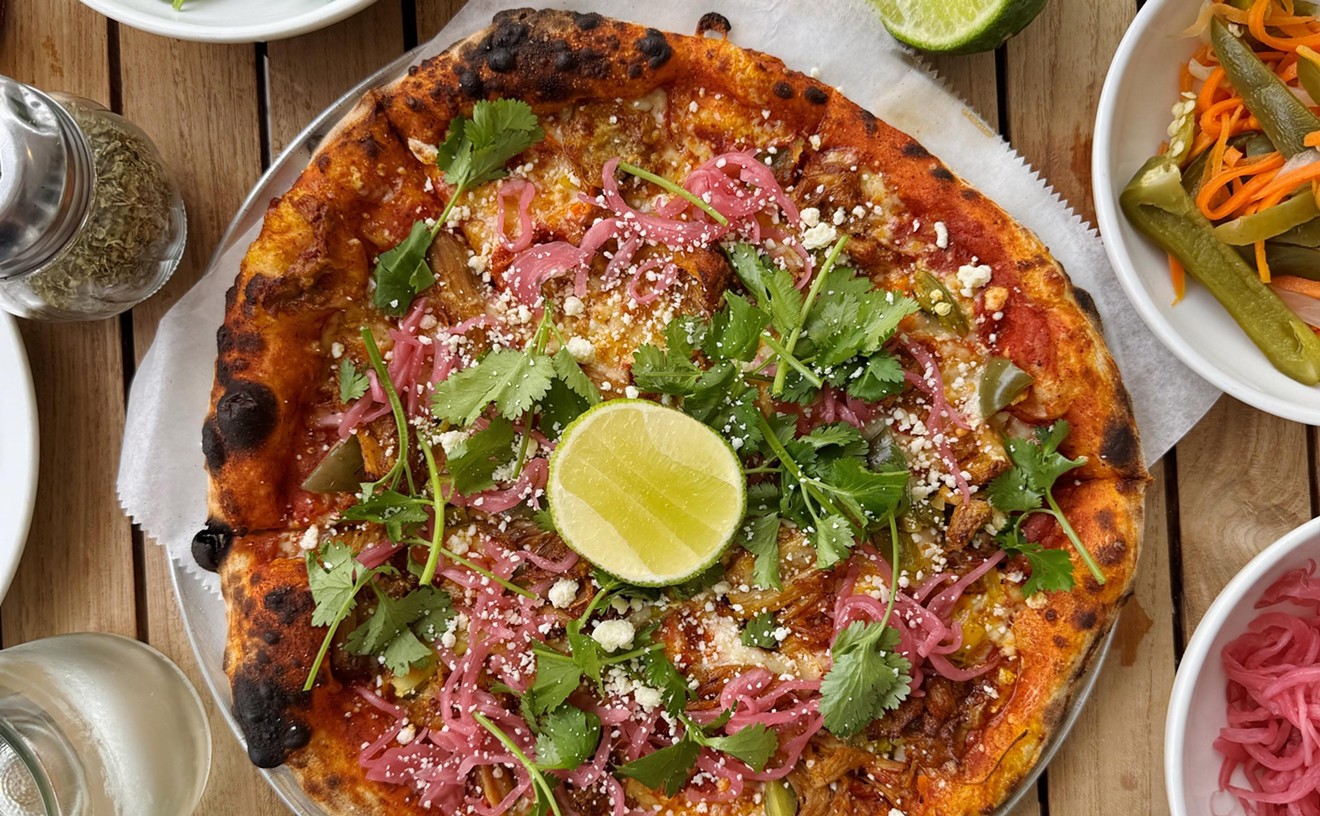Logic fails at Salmon & Salmon Restaurant, where salmon is not a specialty. In fact, it's not even on the menu. Instead, this Peruvian restaurant serves a South American fish, corbina, a member of the saltwater croaker/drum family (so named because these creatures issue an audible ribbit). The salmon syllogism arises from owner/chef Jose's last name, coincidentally that of the familiar red-fleshed fish.
Jose Salmon, who emigrated with his family from Peru in 1959, started Salmon & Salmon with his now deceased father (whence the other Salmon). Though the Salmons had no previous restaurant experience, their charming, 40-seat cafe has survived for twelve years in the same NW Seventh Street location. The restaurant's steady business -- not overwhelming, but what Jose calls "very workable" -- might be due to the comfortable atmosphere in which patrons, most of them regulars, find themselves. A fall of greenery screens the storefront window, creating a rain forest feel; handpainted scenes of Peru dress the walls. Somewhat rickety, upright wooden chairs surround tables that have been covered with pink and terra cotta linens, and decorated, in this holiday season, with cheery, beribboned centerpieces. A giant fishing net drapes the ceiling, and lamps, fashioned to resemble crab traps, dangle here and there. In the wrong space, this homemade decor might look tacky. In Salmon & Salmon, it's appropriately cozy.
A better reason for the eatery's success is Jose's delicious Peruvian dishes. The menu is mostly seafood -- cocktails, ceviches, and main course fillets cooked in sauces -- although a variety of steaks (grilled, fried, or sauced with onions) and even some pasta dishes (topped with tomato sauce, seafood, or a saute of garlic) are also offered. Without question, the ingredients and preparations are satisfying and traditional; the exclusion of one or two Peruvian staples, such as anticuchos, the national appetizer of marinated beef hearts, was only mildly (and not unpleasantly) surprising.
We began our meal with the room-temperature papas a la huancaina, firm boiled potatoes topped by a cheese-green-chili-and-cream sauce. An astonishing saffron color, this tasty dish highlighted one of the few Incan contributions to Peruvian cuisine, the potato. Well suited to the Andes' high altitudes, the potato is to Peru what beans are to Brazil, and more than 100 varieties are cultivated today in the nation's mountainous fields. As is customary, the appetizer arrived heavily garnished with hard-boiled eggs, black olives, and crisp iceberg lettuce. Only the choclo, corn on the cob sliced into two-inch pieces, was missing; choclo, also of ancient Incan origin, is the most common accompaniment to papas a la Huancaina. Though both are starches, the pairing of potatoes and corn is a natural one, given that these are the only two crops the Incas raised.
Choclo was also absent from our sopa marina, or sailor's soup, though it hardly mattered. The core of this hearty soup was a rich, dark broth, enhanced with minced vegetables and a touch of tomato. An incredible array of fresh seafood -- mussels, shrimp, sea scallops, and squid -- filled the bowl; the quantity was as impressive as the quality. Coupled with the complimentary baguette-style rolls, this soup easily could have been a meal.
The same lavish display of seafood cloaked the lean white corbina fillets of the house specialty, a sort of a stew called pescado a lo "Salmon" con mariscos. A dish made for two people, with white rice on the side, the platter amazed us, as did the soup, with its size and savor. Both shrimp and squid, which differ in proper cooking times, were expertly prepared; this is especially unusual for a stew-type dish. And the corbina, flash-fried before being doused with the seafood, retained its flake as well as its appealing flavor. Like the sailor's soup, this dish utilized tomato in its delightfully tangy sauce, but to a greater degree. Given the popularity of the tomato in southern Europe and the Mediterranean, it may appear as if the frequent usage of it in Peruvian and other South American dishes were due to the Spanish invasion. In actuality, the tomato was indigenous to the Americas; it was Cortes who introduced it to Europe, not the other way around.
Another dish, the filete de pescado en salsa verde, was unmistakably influenced by the Spanish, who brought the Peruvians fresh coriander (also known as the pungent herb cilantro). Covered with a light coriander sauce, whitish-green but not creamy, this fillet A corbina again Awas delicate yet firmly fleshed. The fish was sided by buttered white rice and a slab of boiled potato. Here is where Peruvian chefs excel. Jose Salmon obviously knows a potato should yield to the fork, solid but not hard, boiled in salted water just long enough for the tuber to turn its starch into sweetness. The combination of mild starches worked exceptionally well with the fish and coriander sauce.
Coriander also figured largely in a condiment brought with the basket of bread. A thickened combination of the leafy herb, garlic, and some highly stimulating aji chilies, this blend had the consistency of French's yellow mustard and the zeal of Chinese mustard. It proved a zesty counterpoint to the crunchy bread, but we used it sparingly. There was no hospital nearby.
The accumulating toll of starches -- bread, rice, and potatoes --eventually became noticeable, as did the lack of legumes. Though potatoes would seem to have replaced the bean, which is seemingly ever-present in other South American and Caribbean cuisines, Peruvians also enjoy black beans with their meals. But the only other vegetables we saw at Salmon & Salmon were the salad garnishes for the potato appetizer. Still, this was a minor quibble.
A slightly larger problem involved a language barrier. Menus are written in Peruvian Spanish, which differs from other, more common local dialects (not that we're particularly fluent in those, either). After repeated miscommunications with the waitress, we asked for an English menu. Ah, yes! But of course, it made ordering that much simpler. However, because descriptions are nonexistent on both versions, until the food actually arrived, we thought we had ordered salmon for an entree. And after sampling the corbina's distinctly unsalmonlike flavor and texture, we wondered for at least a minute if perhaps "salmon" weren't a generic Peruvian term for all fish. Only at the end of the meal, when we were too full to indulge in flan or tres leches, did we indulge in conversation with our waitress and learn about the croaker family of fish. And the Salmon family of chefs.









